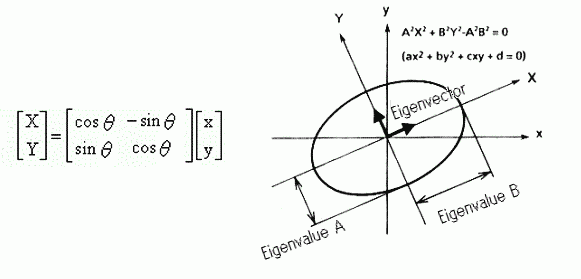 Principal Axis
Principal Axis
A common use of the square root 2, for example, is calculating the length of the diagonal line
of the square when the side lengths are equal to one. If one's destination is the opposite
corner of a square, then all people will walk the diagonal line as a short cut.
This is an example of the transformation of a coordinate system.
The contents of a transformation matrix are the sine and cosine. This matrix is beautiful and useful.
The sum of the squares of the sine and cosine equal one, and the inverse matrix of this
transformation matrix is the same as a transposed matrix.

In the branch of Engineering Mechanics known as statics, you can transform the coordinate
system of the stiffness matrix (F = kx) by pre-multiplying the transposed transformation matrix
by the original stiffness matrix and post-multiplying the transformation matrix by the stiffness matrix.
The result is a transformed stiffness matrix in quadratic form.
Strain and stress matrices are of similar quadratic form. An eigenvalue solution will give you
the principal values of stress or strain and the direction of the principal axis.
If you wish to use only one strain gage, you should put it on the principal axis in order to
measure the maximum strain.
Could it be possible to find out the principal axis by using just your intuition without performing
a mathematical eigenvalue solution? If a structure deforms or moves in the same direction as
the force applied to it, then this shows the direction of its principal axis.
Sometimes you can successfully find the principal axis by simply imagining that you are the structure,
and making a guess about which direction you will move when a force is applied to you.
Fortunately, structures are robust near the principal axis. For this reason, you do not need to
be extremely accurate about the location of the principal axis, because the stress and strains
will be almost the same if even you are only approximately correct in your guess of the principal
axis direction.
In the science of dynamics, the inertia matrix formed by application of Newtons's second law
(F = ma) is also of quadratic form. When the principal axis of the moment of inertia is inclined
at an angle, the direction of the motion is different from the direction of the applied moment.
A gymnast, a springboard diver and even a cat can perform a flip with a twist by changing their
principal inertial axis in the air. It is important to find out the principal axis in order to be a
sophisticated engineer who can find the simple solution to a complicated problem.
Perhaps you may want to find your professional calling, or principal axis, of yourself ?
Home